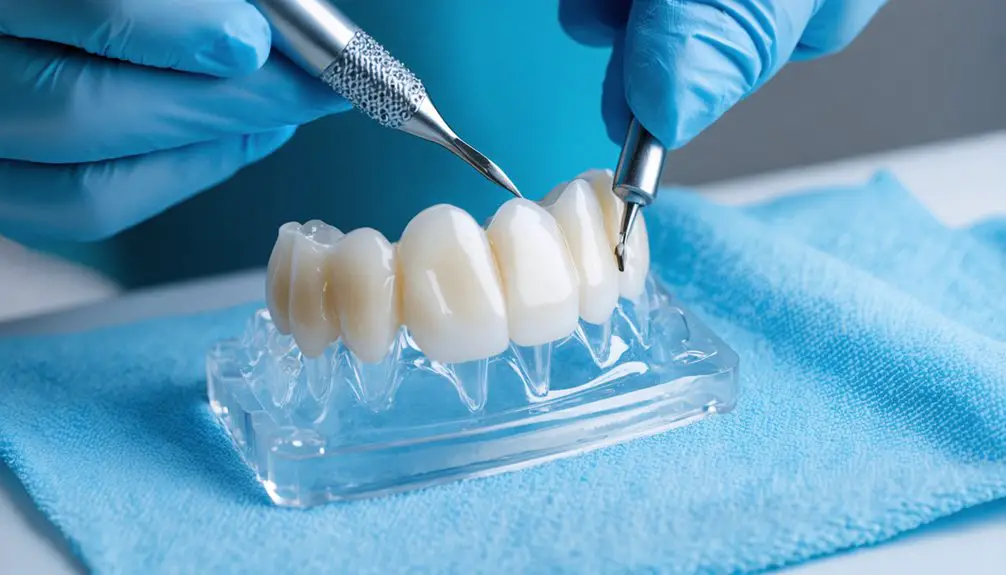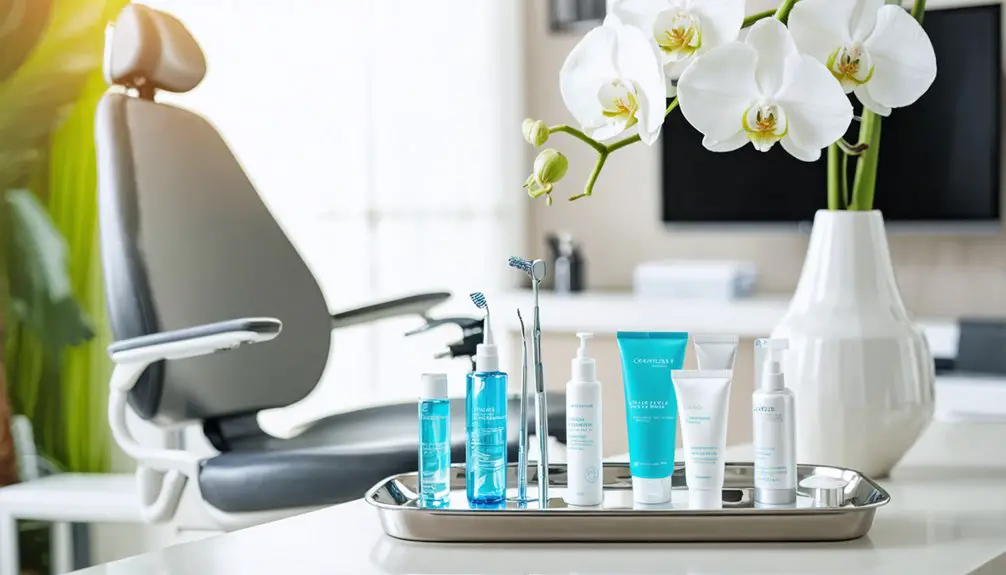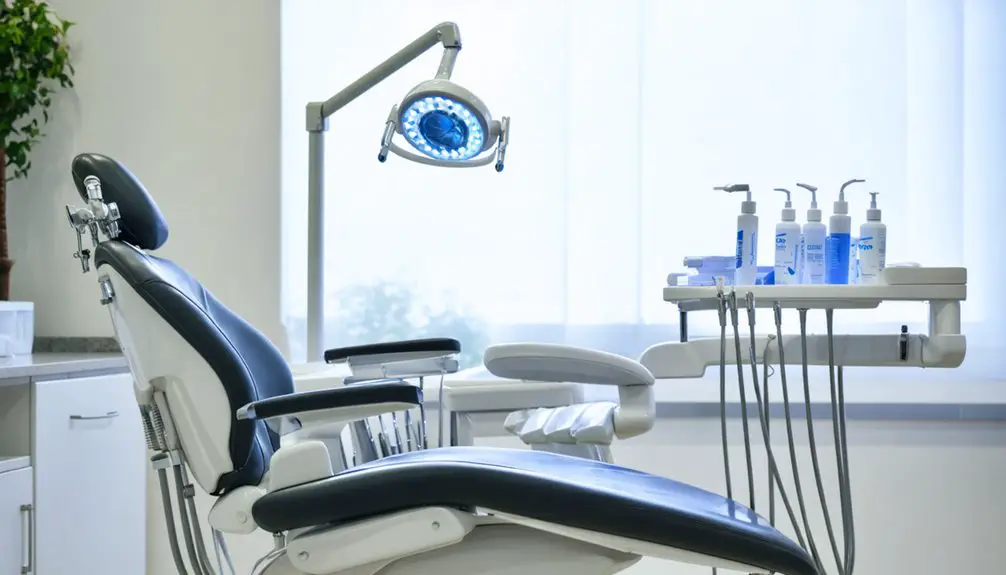Professional teeth whitening offers multiple clinically proven methods utilizing peroxide-based agents. You’ll find in-office treatments like Zoom! whitening that can brighten teeth up to eight shades in 90 minutes, while laser whitening (790nm) energizes peroxide gels for 30-60 minute sessions. Custom-fitted tray systems with carbamide peroxide (10-22%) provide at-home alternatives. Your ideal treatment choice depends on stain type, budget, and time constraints—factors that influence long-term whitening success.
Key Takeaways
- Zoom! whitening treatment achieves up to eight shades lighter in 90 minutes using hydrogen peroxide gel with specialized light activation.
- Laser whitening employs 790nm lasers to energize peroxide gels, delivering dramatic results in 30-60 minutes with optimal sensitivity management.
- Custom-fitted tray systems with carbamide peroxide provide professional-grade results at home over 1-2 weeks of daily use.
- LED whitening systems utilize blue light arrays (450-490nm) for gradual activation of whitening agents with minimal sensitivity.
- Deep bleaching techniques target stubborn intrinsic stains when traditional surface whitening methods prove insufficient.
Understanding Your Professional Teeth Whitening Options
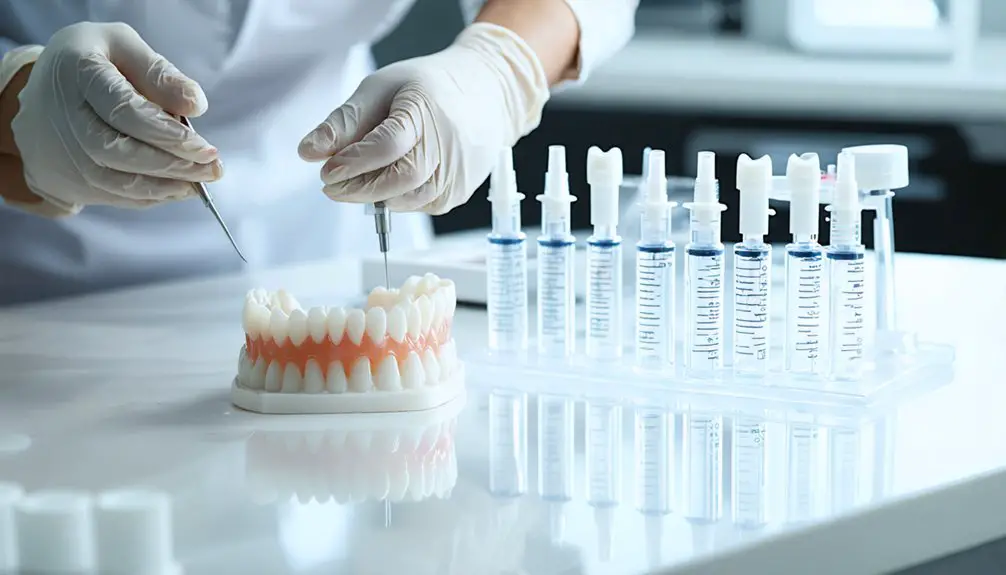
When considering professional teeth whitening, you’ll encounter several clinically proven methods that utilize varying concentrations of peroxide-based bleaching agents.
Despite common whitening myths, professional treatments offer superior results through carefully controlled applications of high-concentration peroxide gels (25%-44%), markedly outperforming over-the-counter alternatives.
Your primary options include in-office treatments like Zoom! whitening, which delivers up to eight shades of improvement in 90 minutes, and custom-fitted tray systems for at-home use. Patients typically experience lasting results for 1-3 years with proper maintenance after Zoom! treatments.
Treatment safety is paramount in professional settings, where your dentist will protect soft tissues before applying whitening agents.
For severe discoloration resistant to traditional bleaching, porcelain veneers provide a permanent solution, though they require removal of natural enamel.
Each method varies in duration, intensity, and maintenance requirements, allowing your dental professional to tailor treatment to your specific needs. Digital scanning technology now enables the creation of perfectly fitting trays that ensure even coverage of whitening gel while minimizing gum irritation.
The Science Behind Laser and LED Whitening Technologies
Although both laser and LED teeth whitening technologies operate through light activation, their mechanisms differ markedly in wavelength, power output, and bleaching efficiency.
Laser activation utilizes high-powered diode or Er:YAG lasers (790nm wavelength) to rapidly energize peroxide gels, creating reactive oxygen species that break down stains within 30-60 minutes. The focused laser energy penetrates deeper into tooth structure while maintaining pulp safety.
LED effectiveness relies on blue light arrays (450-490nm) to activate whitening agents more gradually. While LED treatments require longer sessions, they’re gentler and cost-effective. Multiple treatment sessions are often needed to achieve optimal whitening results.
Both methods employ protective barriers and controlled parameters to minimize sensitivity. Diode lasers operate at 40mW to 2W power, whereas LED systems use lower energy levels, making them suitable for both professional and at-home applications while ensuring enamel integrity.
Comparing Zoom Whitening to Traditional Methods
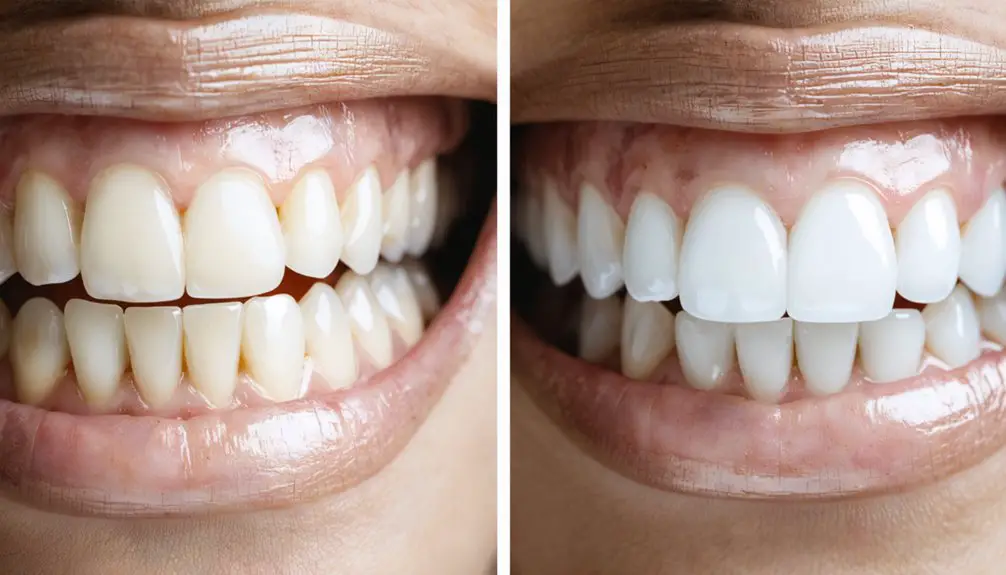
Modern dentistry has revolutionized teeth whitening through Zoom technology, which distinguishes itself from traditional methods through its proprietary combination of hydrogen peroxide gel and specialized light activation.
You’ll notice significant Zoom advantages in treatment time, requiring just 45-90 minutes compared to traditional methods’ multiple visits over weeks. While both approaches deliver whitening effectiveness, Zoom achieves up to eight shades lighter in a single session, outlasting traditional results by several months.
Treatment accessibility varies, with Zoom offering QuickPro options starting at $125, though traditional methods may cost less initially. Sensitivity concerns are managed through Zoom’s specialized formulation containing desensitizers and ACP.
When examining cost comparisons, consider that Zoom’s thorough treatment at $500 includes both in-office and maintenance care, potentially offering better long-term value.
At-Home Professional Solutions: Tray Systems and Rinses
Two primary at-home professional whitening solutions – tray systems and rinses – offer varying degrees of effectiveness in teeth bleaching.
Tray effectiveness stems from custom-fitted molds delivering controlled amounts of carbamide peroxide (10-22%) or hydrogen peroxide directly to tooth surfaces. You’ll typically wear these trays for 30 minutes to several hours daily over 1-2 weeks.
While tray systems demonstrate comparable results to in-office treatments over extended periods, rinse convenience comes with reduced efficacy. Whitening rinses contain lower peroxide concentrations (1-2%) and require brief 60-second applications. You’ll need to use them twice daily for 2-4 weeks to see results.
Both methods primarily target natural teeth, though tray systems better address both extrinsic and intrinsic stains compared to rinses’ surface-level action.
Long-Term Results and Maintenance Strategies
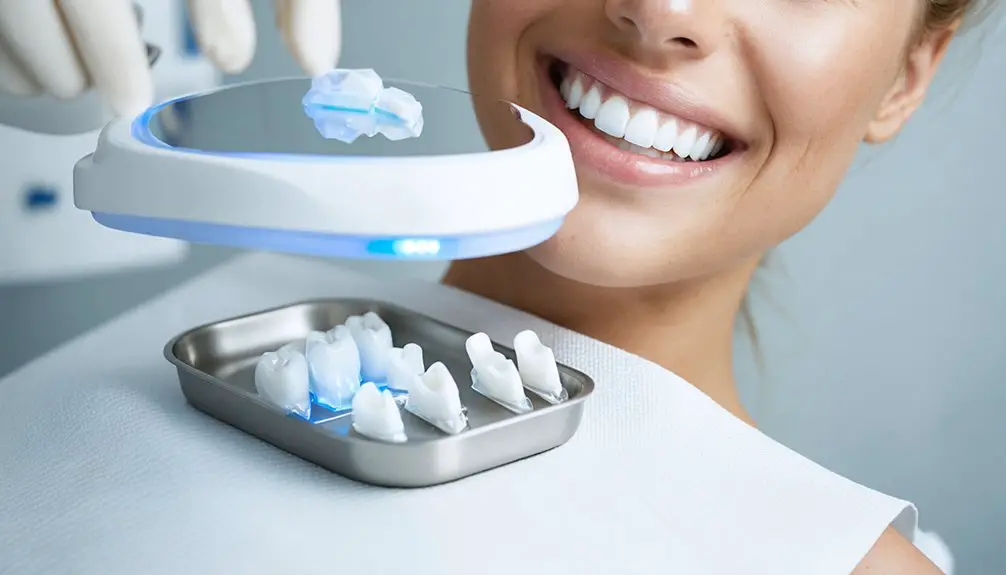
Since professional teeth whitening can lighten teeth by up to 10 shades with a 90% success rate, understanding the duration and maintenance of results becomes essential for treatment planning.
Whitening longevity typically ranges from several months to 2-3 years, depending on individual factors and lifestyle habits. You’ll need to implement specific maintenance practices to optimize long-term results.
To extend your whitening effects, you’ll want to minimize exposure to staining substances like coffee, tea, and red wine.
Adopt enhanced oral hygiene practices, including regular brushing with whitening toothpaste and consistent flossing.
You’ll benefit from scheduling periodic professional cleanings and touch-up treatments.
Research shows that patients who undergo professional whitening demonstrate improved long-term oral hygiene compliance, which greatly contributes to sustained results through reduced plaque and staining accumulation.
Cost Analysis of Different Whitening Procedures
When evaluating teeth whitening options, you’ll encounter significant cost variations between in-office procedures ($300-$1,000) and at-home methods ($5-$600), with professional treatments commanding premium prices for their immediate results.
Professional in-office whitening delivers dramatic shade improvements within a single session, while at-home methods require extended treatment periods of four to six months for comparable results. Professional whitening treatments can effectively lighten teeth up to eight shades in one visit. Most dental insurance plans consider teeth whitening a cosmetic procedure and typically do not provide coverage.
The long-term investment analysis must consider the durability of results, maintenance requirements, and the potential need for periodic touch-ups, which can affect the overall cost-effectiveness of your chosen whitening method.
Upfront Vs Long-Term Expenses
Making an informed decision about teeth whitening requires careful consideration of both immediate and long-term financial implications.
While you’ll encounter higher upfront costs with professional in-office treatments ($300-$1,000), their lasting results of up to three years can translate to significant long-term savings.
Conversely, over-the-counter products present minimal initial investment but demand frequent repurchases due to their limited effectiveness.
Professional treatments offer superior whitening power, lightening teeth up to eight shades in one session.
This efficiency, combined with proper dental supervision, helps prevent costly complications from improper whitening techniques.
When calculating your investment, consider that dentist-prescribed at-home kits ($275-$600) represent a middle-ground option, requiring periodic touch-ups every 4-6 months but delivering more reliable results than OTC alternatives.
In-Office Versus At-Home Costs
As dental professionals analyze the cost implications of teeth whitening procedures, considerable price variations emerge between in-office and at-home treatment options.
In-office pricing typically ranges from $300 to $1,000 per session, with premium laser treatments averaging $792. You’ll achieve dramatic results in just 60 minutes, lightening your teeth by 5-8 shades.
At-home affordability presents a more economical alternative, with professional take-home kits ranging from $100 to $600. While these kits require 4-6 months of consistent use, they offer flexibility in application.
The cost difference reflects the varying levels of professional supervision, equipment quality, and treatment duration. In urban areas, you’ll find broader pricing ranges, particularly for in-office treatments, where provider expertise and facility location influence costs considerably.
Choosing the Right Treatment for Your Dental Needs
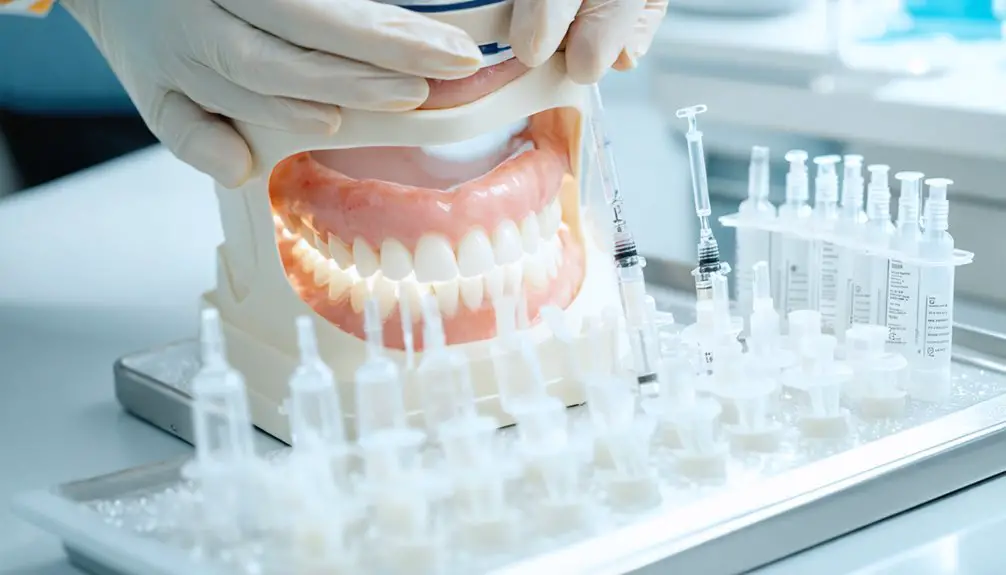
You’ll need to evaluate whether your tooth discoloration stems from surface stains or deeper intrinsic staining to determine the most effective whitening approach.
When comparing treatment options, consider both the initial investment and the duration of results – professional in-office treatments command higher costs but deliver immediate results lasting 1-2 years, while at-home methods cost less but require extended application periods and more frequent maintenance.
Your lifestyle factors, such as coffee consumption or smoking, will greatly impact the longevity of any whitening procedure and should influence your choice between periodic touch-ups with LED systems versus more intensive professional treatments.
Assess Your Stain Type
Before selecting a teeth whitening treatment, determining the precise type and location of dental stains is essential for best results.
You’ll need to understand whether you’re dealing with extrinsic stains on the tooth surface, intrinsic stains within the tooth structure, or internalized stains that have penetrated deeper layers.
Stain identification techniques involve examining color patterns and distribution: yellow-brown surface stains typically indicate extrinsic causes like coffee or tobacco, while blue-gray bands suggest intrinsic tetracycline staining.
Through whitening efficacy comparison, you’ll find that extrinsic stains often respond well to professional cleaning and surface whitening treatments, while intrinsic stains may require more aggressive approaches like deep bleaching or veneers.
Your dentist can perform a thorough assessment to determine the most effective treatment path.
Compare Cost Vs Duration
Selecting a preferred teeth whitening treatment involves careful analysis of both cost investment and treatment duration parameters.
When evaluating treatment duration versus expenditure, laser whitening offers the most rapid results within 30-60 minutes at $600-$1,200, while Zoom whitening delivers comparable outcomes in 90 minutes for $300-$650.
Professional tray-based systems, though requiring 1-2 weeks of consistent use, present a cost-effective option at $200-$400.
LED-activated treatments balance moderate pricing ($150-$300) with intermediate treatment duration of 5-7 days.
For severely stained teeth resistant to conventional whitening, porcelain veneers provide a permanent solution at $1,000-$2,500 per tooth but require multiple visits over several weeks.
Consider your budget constraints and time availability when selecting the most suitable professional whitening method.
Frequently Asked Questions
Can I Whiten My Teeth While Wearing Braces or Dental Appliances?
You’ll get uneven results whitening with traditional braces, but can maintain brightness using specialized toothpaste. Consider professional whitening after braces removal for ideal, uniform results with clear aligners.
How Long Should I Wait After Dental Work Before Getting Teeth Whitening?
Picture your smile healing like a fresh garden: You’ll need to wait 7-14 days after fillings, 4-8 weeks post-gum surgery, and 2 weeks between whitening and new dental work for ideal post-treatment care.
Does Smoking Affect the Success Rate of Professional Teeth Whitening Treatments?
Yes, smoking considerably reduces your whitening duration and success. You’ll experience slower results, faster staining relapse, and need more frequent touch-ups due to tobacco’s deep-staining effects on your enamel.
Are There Natural Alternatives That Work as Well as Professional Whitening?
Natural remedies like baking soda and activated charcoal don’t match professional whitening’s effectiveness. While they’ll remove surface stains, you won’t achieve the same dramatic results as clinical-grade treatments.
Can Teeth Become Too White or Over-Bleached From Professional Treatments?
After seeing patients with chalky-white, translucent teeth, you’ll want to avoid over-bleaching. Your teeth can become unnaturally bright, with whitening risks including enamel damage. Stay within ideal shades your dentist recommends.
References
- https://www.champaigndentalgroup.org/about-us/blog-articles/top-professional-teeth-whitening-techniques-2024-effective-safe
- https://lanedds.com/which-teeth-whitening-technique-lasts-longest/
- https://pmc.ncbi.nlm.nih.gov/articles/PMC4058574/
- https://www.arthurglosmandds.com/blog/different-methods-of-teeth-whitening/
- https://www.culvercitydentist.com/blogs/teeth-whitening/laser-vs-zoom-whitening
- https://drrenudentalclinic.com/laser-teeth-whitening-treatment-work/
- https://www.interesjournals.org/articles/different-types-of-laser-use-in-teeth-bleaching.pdf
- https://www.healthline.com/health/dental-and-oral-health/laser-teeth-whitening
- https://artisticsmilesmiamidentist.com/blog/laser-teeth-whitening-vs-led-teeth-whitening/
- https://www.dentistatplumcreek.com/blog/how-laser-dentistry-transforms-teeth-whitening-results/
